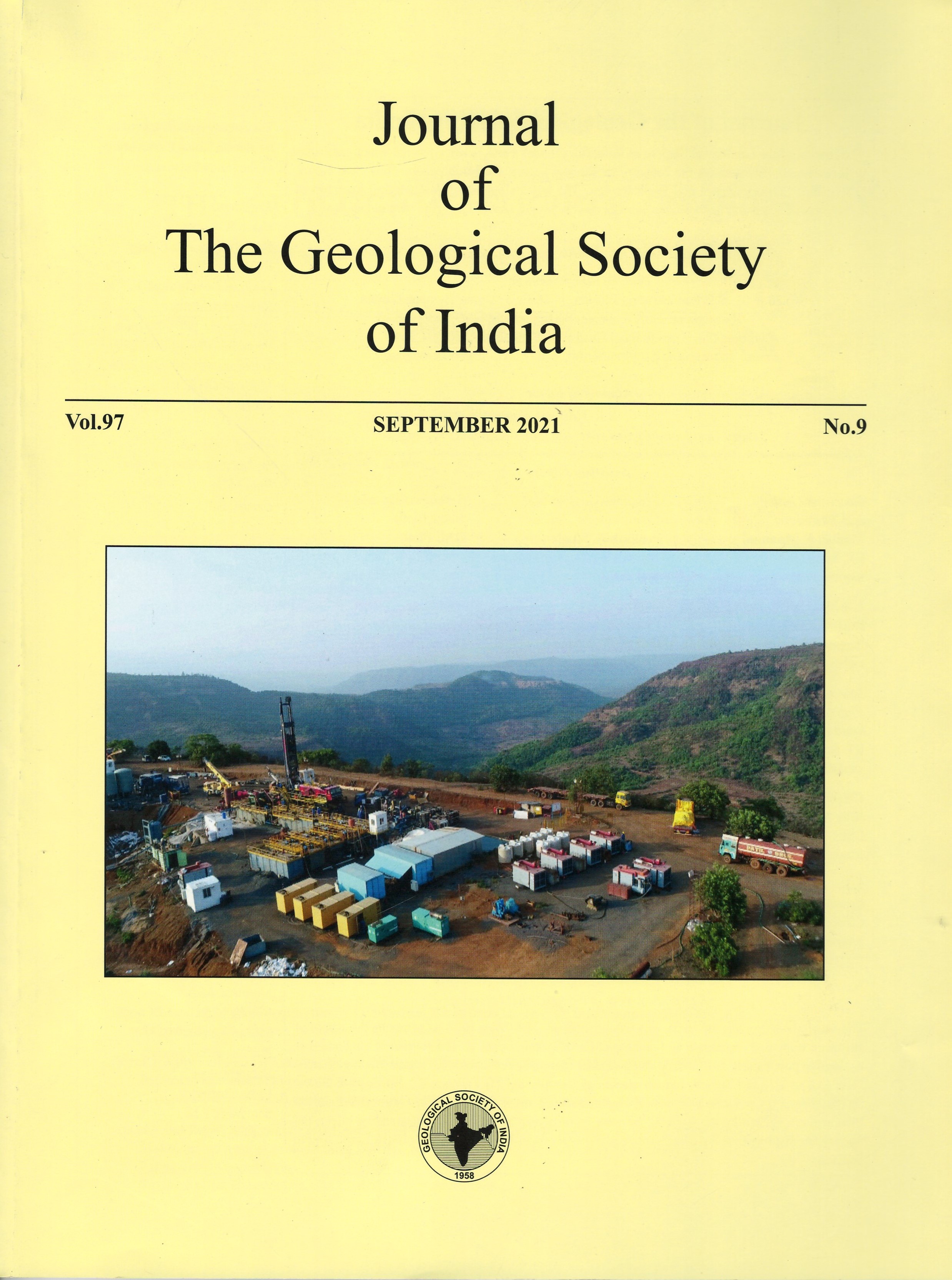Copper and Associated Uranium Mineralisation in Mayurbhanj Granite Batholith, Kesharpur-Madansahi-Dudhiasol Sector, Eastern India: A Promising Future Prospect
DOI:
https://doi.org/10.1007/s12594-021-1816-xKeywords:
No KeywordsAbstract
Appreciable amount of copper mineralisation dominated by chalcopyrite along with incidence of uranium within the Mayurbhanj granite batholith in Kesharpur-Madansahi-Dudhiasol sector has been established through preliminary exploration (UNFC-G3). Chalcopyrite-pyrite-pyrrhotite assemblages along with minor pentlandite seems to be preferably controlled through secondary structural shear fabric and vein selvages along the contact zones of granite and country rocks viz. hornblende biotite schist and metabasics. Hydrothermal alteration is notably marked by potassic, propyllitic and phyllic zones besides wide chloritisation and silicification in close proximity and within mineralised zone. Three potential prospects of significant copper mineralisation in terms of thickness and grade have been brought out at Kesharpur, Madansahi and Dudhiasol. These prospects show a linear lensoidal synformal disposition of the ore body trending NE-SW in eastern part to E-W in central part and NW-SE in the western part with moderate to steep northerly dipping. Out of these three prospects, Madansahi is quite promising where thickness of copper lodes varying from 2.00 m to 18.35 m and grade varies from 0.20% Cu to 1.76% with maximum nickel concentration of up to 0.13% Occurrence of copper mineralisation along with nickel concentration and anomalous uranium values up to 0.045% U3O8 is a significant achievement in establishing polymetallic mineralisation and augmenting the mineral resources in eastern India.
Downloads
Metrics
Issue
Section
Downloads
Published
How to Cite
References
Acharyya, S.K., Gupta, A., Orihashi, Y. (2010) New U-Pb zircon ages from Paleo- Mesoarchean TTG gneisses of the Singhbhum Craton, Eastern India. Geochem. Jour., v.44, pp.81–88.
Bhattacharya, H.N. and Mahapatra, S. (2008) Evolution of the Proterozoic rift margin sediments- North Singhbhum Mobile Belt, Jharkhand-Odisha, India. Precambrian Res., v.162, pp.302–316.
Bose, M.K. (2009) Precambrian mafic magmatism in the Singhbhum craton, eastern India. Jour. Geol. Soc. India, v.73, pp.13–35.
Chakaraborti, T.M., Ray, A., Deb, G.K., Upadhyay, D. and Chakrabarti, R. (2019) Evidence of crustal reworking in the Mesoarchean: Insights from geochemical, U-Pb zircon and Nd isotope study of 3.08-3.12 Ga ferropotassic granite gneiss from north-eastern margin of Singhbhum Craton, India. Lithos, v.330-331, pp.16-34.
Das, L.K., Dasgupta, K.K. and De, M.K. (2008) Mineral potential of Dhanjori metavolcanics, East Singhbhum, Jharkhand. Indian Minerals, v.61(3-4) & 62(1-4), pp.193-200.
Dunn, J.A. (1929) The geology of north Singhbhum including parts of Ranchi and Manbhum districts. Mem. Geol. Surv. India, v.54, pp.1–166.
Dunn, J.A. (1937) Mineral deposits of eastern Singhbhum and surrounding areas. Mem. Geol. Surv. India, v.69, pp.1–279.
Dunn, J.A., Dey, A.K. (1942) The geology and petrology of eastern Singhbhum and surrounding areas. Mem. Geol. Surv. India, v.69, pp.281–456.
Mahanta, H., Samala, S.K., and Khan, I. (2020) Preliminary exploration for copper and associated precious metal mineralisation in Madansahi block, Mayurbhanj district, Odisha. Geol. Surv. India, Unpubld., report for the F.S. 2018-19.
Misra, S. (1999) The Mayurbhanj granite: Its nature, tectonic setting, mode of emplacement and pressure-temperature of magma generation. Indian Jour. Geol., v.71(1 & 2), pp.33-52.
Misra, S., Sarkar, S.S. and Ghosh, S. (2002) Evolution of Mayurbhanj Granite Pluton, eastern Singhbhum, India: a case study of petrogenesis of A-type granite in bimodal association. Jour. Asian Earth Sci., v.20, pp.965-989.
GSI (2012) Geology and Mineral Resource of Odisha. Geol Surv. Idnia, Misc. Publ. no.30, Part III.
Mukhopadhyay, D. and Deb, G.K. (1995) Structural and textural development in Singhbhum shear zone, eastern India, Proc. Indian Acad. Sci. (Earth Planet. Sci.), v.104(3), pp.385-405
Mukhopadhyay, J., Beukes, N.J., Armstrong, R.A., Zimmermann, U., Ghosh, G., Medda, R.A. (2008) Dating the oldest greenstone in India: A 3.51 Ga precise U-Pb SHRIMP zircon age for dacitic lava of the southern Iron Ore Group, Singhbhum craton. Jour. Geol., v.116, pp.449–461.
Nelson D.R., Bhattacharya, H., Thern, E.R. and Altermann, W. (2014) Geochmical and ion-microprobe U-Pb zircon constaints on the Archean evolution of Singhbhum Craton, eastern India. Precambrian Res., v.255, pp.412-432.
Pal, D.C., Sarkar, S., Misra, B., Sarangi, A.K. (2011) Chemical and sulfur isotope compositions of pyrite in the Jaduguda U (-Cu-Fe) deposit, Singhbhum shear zone, eastern India: Implications for sulphide mineralisation. Earth Syst. Sci., v.120, pp.475–488.
Pal, D.C., Rhede, D. (2013) Geochemistry and chemical dating of uraninite in the Jaduguda uranium deposit, Singhbhum Shear Zone, India- Implication for uranium mineralisation and geochemical evolution of uraninite. Econ. Geol., v.108, pp.1499–1515.
Pattnaik, S.C., Mohanty, A.K., Raj, P.C., Gupta, A., Syamlal Rao, A., Hore, T.B., Acharya, B.K. and Mahesh Babu M. (1996) Report on the investigation for copper ore in Kesharpur area, Mayurbhanj district, Odisha, Geol. Surv. India Unpubld. report for FS -1968-69 to 1976-77.
Saha, A.K. (1975) The Mayurbhanj Granite, a Precambrian batholith in eastern India. Jour. Geol. Soc. India v.16(1), pp.37-43.
Saha, A.K., Bose, R., Ghosh, S.N. and Roy, A. 1977. Petrology and emplacement of Mayurbhanj Granite batholith, eastern India. Evolution of Orogenic Belts of India (Part 2), Bulletin of the Geological Mining and Metallurgical Society of India,v.49,pp. 1-34.
Saha, A.K., Ray, S.L., Sarkar, S.N. 1988. Early history of the earth: evidence from the eastern Indian shield. In D. Mukhopadhyay (Ed.), Precambrian of the Eastern Indian Shield. Mem. Geol. Soc. India, No. 8, pp. 13-38.
Saha, A.K. 1994. Crustal evolution of Singhbhum-North Odisha, eastern India. Mem. Geol. Soc. India, no.27, 341p.
Sarkar, S.C., Deb, M. and Roy chowdhury, K., 1976. Sulphide ore mineralisation along Singhbhum shear zone, Bihar. Jour. Geol. Soc. Mining Japan, Spec. Issue 3, pp.226-234.
Sarkar, S.N., Saha, A.K., Miller, J.A. (1969) Geochronology of the Precambrian rocks of Singhbhum and adjacent regions, eastern India. Geol. Mag., v.106, pp.1545.
Sarkar, S.N., Ghosh, D., Lambert, R.J. St (1986) Rb-Sr and Pb isotope studies of the Soda granite from the Mosabani, Singhbhum copper belt, eastern India. Indian Jour. Earth Sci., v.13, pp.101–116.
Sengupta, S., Paul, D.K., Bishui, P.K., Gupta, S.N., Chakraborty, R., Sen, P. (1994) A geochemical and Rb-Sr isotopic study of Kuilapal granite and Arkasoni granophyres from the eastern Indian craton. Indian Minerals, v.48, pp.77-88.
Sharma, R.S. (2009) Cratons and fold belt of India. Books on lecture notes in Earth Science, Springer.

 Haraman Mahanta
Haraman Mahanta






